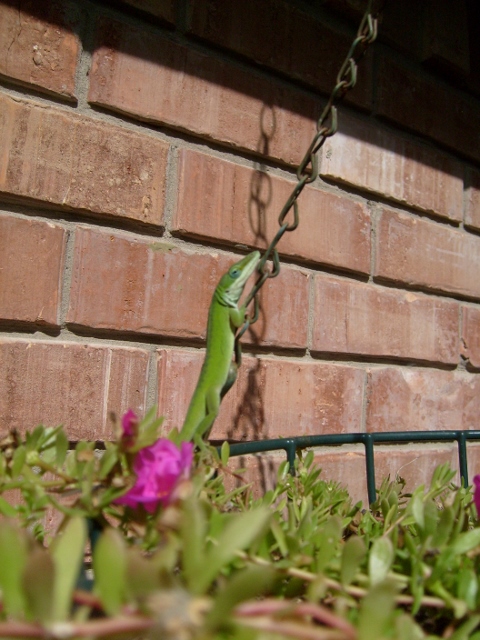by M. Kathy Raines

Glancing from my book, I delighted to glimpse the ballooning speckled pink dewlap, or throat fan, of a green anole as it did push-ups against the wall of the gazebo.
Noticing me a few photographs later, it leapt onto a nearby leaf, instantly changing from green to brown.
“It’s a chameleon!” many cry, watching a green anole convert from brown to emerald as it skitters into foliage. But chameleons, Old World lizards, do not inhabit this hemisphere. We have anoles (pronounced “uh-NOH-lees”), both the green (Anolis carolinensis), a Rio Grande Valley native, and the brown (Anolis sagrei), an introduced species from the Caribbean which has proliferated in Florida and now flourishes here.
A green anole does not match its color to green leaves. Rather, its hormones prompt the change based on light, temperature and the creature’s level of excitement. A basking anole tends to be brown, a scared or combative one, green. It usually sleeps in green. Direct sunlight prompts a green color, cloudy skies, brown.
Brown anoles change hues, but much more subtly. An aggressive brown anole, displaying its dewlap, may turn black. Relaxing, it returns to its lighter shade, one more conducive to camouflage. They never turn green.

These slender lizards reach from five to eight inches from snout to tail, with the tail double the body’s length. Claws extend beyond their toe pads, which are coated with setae, hair-like projections that allow anoles to adhere to the trunks and posts they zip up and down.
A brown anole sports patterned skin and a dark stripe down its back; small yellow spots adorn some males. A green anole has evenly-colored skin and a longer snout. A brown male grows a crest, called a “roach”, with which, along with its reddish-orange, yellow-bordered dewlap, it both impresses females and challenges males. A male often turns sideways, presumably to present a clear imagine of its prominent roach and dewlap. A green anole bears a pink dewlap and a smaller crest, one most notable during displays. Females of both species may exhibit lighter-colored dewlaps.
Daytime hunters, anoles lie in wait for spiders and insects, then spring after them. They also stalk and ambush prey. A green anole, like some spiders, may sit near a blossom, snagging insects its nectar attracts. Anoles also eat worms, mollusks, tiny fish or sometimes even grain and seeds.
Anoles molt several times a year, stripping skin with their mouths, sometimes eating it. Unlike a snake, their skin peels off in sections, not in one piece.
Anoles, trusting to camouflage, do not startle easily and, when threatened, often freeze. Though a scant few inches off, I snapped multiple close-ups of a brown anole, alert, back-arched, head pointed downwards along a post.
Anoles fight. Green ones chase each other into trees, from which they tumble, then dash back up. Bobbing, spreading dewlaps, opening jaws and biting, anoles circle cautiously, shaking their heads till one or both fall off a branch.
In springtime, a male entices a female, bobbing and fanning his brilliant dewlap. If interested, she turns her head to one side, arching her neck and pointing her snout downwards. With his jaws, the male clasps a skin fold on the female’s neck, preventing interruption and escape, and he twines his tail around hers for stability. Some females bear scars from this roughness.
Throughout summer, a female green anole lays one or two white oval eggs every eight days into damp leaves or rotten wood. She may push an egg with her snout, rolling it to a more suitable location. Eggs hatch in from five to seven weeks. Anoles can store sperm for as long as seven months, so delayed fertilization may be possible. A brown anole lays a single round egg every two weeks until autumn, with eggs hatching in from 40 to 60 days.
Parents ignore newborn anoles, which look like mini-adults. While green anoles remain nearby, brown ones stake out new turf. Female green anoles can mate at from eight to nine months, browns, at a year.
Snakes, birds, dogs and cats prey on anoles, our pets finding them to be engaging toys. When threatened, an anole may drop its tail, which continues to wiggle, creating a distraction. The tail regrows in about two months.
Green and brown anoles currently share habitat. Greens, however, may climb high into vegetation while browns dwell closer to the ground, ascending no higher than five feet. Both species like a moist, vegetation-rich environment.
Many fear that the brown anole, which reproduces more rapidly, will displace the native green one, a phenomenon Floridians began noticing in the last century. Apparently, brown anoles have hitched rides throughout the South by laying their eggs in transported soil and plants, arriving in garden departments, then our yards.
Countless brown anoles skitter through Turk’s cap and aloe vera and adhere to fence posts and bricks in my Brownsville yard, but I haven’t spotted a green one there in a year. Some residents continue seeing them, however.
Rumors that brown anoles devour green ones are unfounded, though both species have eaten each other’s eggs. Brown anoles may have driven green ones higher into trees where we don’t see them.
Brown anoles appear to flourish in fragmented, disturbed environments, while green ones, now in competition, may depend more upon protected woodlands; they continue to thrive in undisturbed forests of refuges like Sabal Palms, Estero Llano and Resaca de la Palma State Park.
Brown anoles are apparently here to stay. However, to foster native green ones, we must protect our forests and wetlands. Also, planting native vegetation encourages more insects and, naturally, more insect-eaters like anoles.

